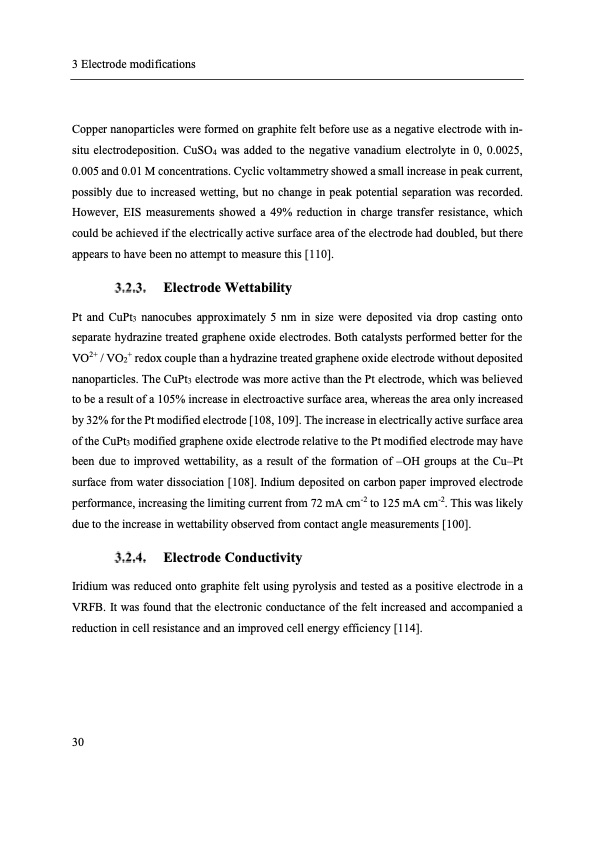
PDF Publication Title:
Text from PDF Page: 042
3 Electrode modifications Copper nanoparticles were formed on graphite felt before use as a negative electrode with in- situ electrodeposition. CuSO4 was added to the negative vanadium electrolyte in 0, 0.0025, 0.005 and 0.01 M concentrations. Cyclic voltammetry showed a small increase in peak current, possibly due to increased wetting, but no change in peak potential separation was recorded. However, EIS measurements showed a 49% reduction in charge transfer resistance, which could be achieved if the electrically active surface area of the electrode had doubled, but there appears to have been no attempt to measure this [110]. Electrode Wettability Pt and CuPt3 nanocubes approximately 5 nm in size were deposited via drop casting onto separate hydrazine treated graphene oxide electrodes. Both catalysts performed better for the VO2+ / VO2+ redox couple than a hydrazine treated graphene oxide electrode without deposited nanoparticles. The CuPt3 electrode was more active than the Pt electrode, which was believed to be a result of a 105% increase in electroactive surface area, whereas the area only increased by 32% for the Pt modified electrode [108, 109]. The increase in electrically active surface area of the CuPt3 modified graphene oxide electrode relative to the Pt modified electrode may have been due to improved wettability, as a result of the formation of –OH groups at the Cu–Pt surface from water dissociation [108]. Indium deposited on carbon paper improved electrode performance, increasing the limiting current from 72 mA cm-2 to 125 mA cm-2. This was likely due to the increase in wettability observed from contact angle measurements [100]. Electrode Conductivity Iridium was reduced onto graphite felt using pyrolysis and tested as a positive electrode in a VRFB. It was found that the electronic conductance of the felt increased and accompanied a reduction in cell resistance and an improved cell energy efficiency [114]. 30PDF Image | Electron Transfer Kinetics in Redox Flow Batteries

PDF Search Title:
Electron Transfer Kinetics in Redox Flow BatteriesOriginal File Name Searched:
electron-transfer-flow-batteries-thesis.pdfDIY PDF Search: Google It | Yahoo | Bing
Salgenx Redox Flow Battery Technology: Salt water flow battery technology with low cost and great energy density that can be used for power storage and thermal storage. Let us de-risk your production using our license. Our aqueous flow battery is less cost than Tesla Megapack and available faster. Redox flow battery. No membrane needed like with Vanadium, or Bromine. Salgenx flow battery
| CONTACT TEL: 608-238-6001 Email: greg@salgenx.com | RSS | AMP |